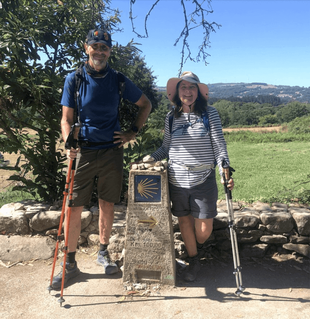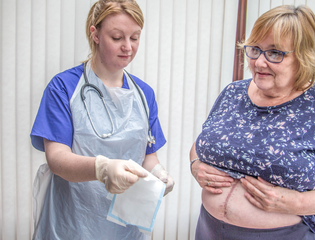TARGETED THERAPIES FOR OVARIAN CANCER

Targeted therapies for ovarian cancer.
Cancer occurs when genetic mutations in our cells cause them to multiply uncontrollably and accumulate to form a tumour.
Targeted cancer therapies are drugs that can stop the spread of cancer by identifying and blocking the genetic changes responsible for the cancer’s growth and spread. They are designed to target cancer cells while reducing the damage to normal, healthy cells.
There are different targeted therapies available to women with ovarian cancer. Find out more about these medicines and how they work below.
Who decides which of these drugs I can take?
Access to targeted therapies is decided by different bodies depending on where in the UK you live.
In England, which drugs are available on the NHS is decided by National Institute for Health and Care Excellence (NICE).
In Wales, generally the guidance produced by NICE is followed but this is overseen by the All Wales Medicines Strategy Group (AWMSG)
In Northern Ireland, the Department of Health makes decisions, but they often follow NICE.
In Scotland, the Scottish Medicines Consortium (SMC) makes decisions about NHS Scotland and this is not related to NICE decisions.
Targeted treatments for ovarian cancer are available in specific situations, depending on the type and stage of your cancer, results of tumour testing and also other health issues you may have. The guidelines and eligibility can be very confusing. Your cancer team will be able to talk you through what you may be eligible to take and when. If there isn’t access through standard channels, they may also be able to advise you on trials that could be available based on your diagnosis.
PARP inhibitors
What are PARP inhibitors?
PARP inhibitors are a new class of targeted cancer drug or maintenance treatment, that is becoming more common in ovarian cancer treatment.
They can prevent the spread of cancer by stopping a protein called PARP from performing its usual job of helping damaged cells repair themselves. PARP inhibitors can stop (‘inhibit’) this repair process from happening in damaged ovarian cancer cells, and this causes the cancer cells to weaken and die. This can reduce the chances of the cancer returning, or lengthen the time before it does.
There are currently three PARP inhibitors available for ovarian cancer:
- olaparib (Lynparza®)
- niraparib (Zejula®)
- rucaparib (Rubraca®)
The name on the left is what most people call the drug, and the one in brackets is its brand name.
Who are PARP inhibitors for?
PARP inhibitors are available for high grade serous ovarian cancer patients diagnosed at stages 3 or 4, and who have responded well to platinum-based chemotherapy.
At what stage of treatment can I take a PARP inhibitor?
PARP inhibitors are given after a woman has received treatment using platinum chemotherapy that has shown a positive result, with the goal of maintaining the effect of the chemotherapy on the cancer.
PARP inhibitors are now available at first line, meaning straight after you finish your chemotherapy treatment. Which one you may be offered depends on the results of tests done on your tumour and on your own individual health. You may hear your cancer team talking about BRCA and HRD testing in relation to this.
It’s also possible to take PARP inhibitors if your cancer returns (known as a recurrence) so long as you didn’t take a PARP inhibitor at first line. This is known as second line treatment.
If your cancer returns again, this is known as third line treatment.
The options available at each line of treatment are related to your individual circumstances, so speak to your cancer team if you want to know more.
How are PARP inhibitors given?
They are taken as tablets or capsules that you take yourself by mouth at home. You normally start taking them 8-12 weeks after you finish chemotherapy.
“Unlike chemotherapy where you have to go to hospital and be rigged up to have it by IV, Niraparib is tablet form so the onus is very much on me to remember to take it.”
What are the side effects?
The side effects people can have when they start taking PARP inhibitors can worry them, but there will be careful monitoring by your team. For many people the side effects reduce after the first three months.
Side effects do differ depending on which PARP inhibitor you take, but some common side effects include:
-Increased risk of infection
-Anaemia
-Increased bruising/ bleeding
-Nausea/ sickness
-Diarrhoea/ constipation
-Indigestion
-Fatigue
-Headaches
-High blood pressure
You will have regular blood tests to monitor your blood cells, and your kidney and liver function.
It’s important to let your cancer team know of any side effects that you experience. Often there are ways your team can help make you feel better. If there are side effects that aren’t easily improved or they are impacting your quality of life, with some PARP inhibitors it is possible to reduce the dose, without impacting how effective the drug is.
Some of our supporters have told us about their experiences of the side effects of PARPs:
“I have a little bit of nausea and fatigue at the mo, but it’s nothing like when I was on chemo and I am told those symptoms will abate as my body learns to tolerate the treatment.”
“Niraparib: AMAZING! Although I had issues with low platelets initially, once put on the right dose, I have no known side effects.”
“Apart from the first three months on the PARP which was tough (side effects such as really bad nausea/fatigue etc) I live a wonderful, manageable life.”
What do our supporters tell us about PARP inhibitors?

Michelle on a hike
“In January 2022 my CA125 started to rise and a recurrence was diagnosed. Six cycles of carboplatin sorted that out. At this point I was started on a PARP inhibitor called rucaparib. This treatment is a comforting safety net to an extent although I’m fully aware it’s not a guaranteed cure. I’ve tolerated this well until a very low haemoglobin necessitated a blood transfusion and now I take a reduced dose which is suiting me well. Having the rucaparib has been a massive thing. I’m so grateful for the people who went through the trials that meant these drugs could be manufactured and approved so we can benefit from them”
Other supporters tell us:
“For my whole family my diagnosis was painful and upsetting, including all the time taking me to treatment and seeing the side effects. I am now on a PARP inhibitor so have to go to the hospital less and this has really helped reduce the toll on my daughter”
“Niraparib means I can get on with doing things and feeling healthy while at the same time knowing something is suppressing the tumours which feels more proactive than just waiting. I’m able to do things I couldn’t do on chemo- travel, improve my Italian, go to the opera again.”
“So far I've been on Olaparib 20 months. The most amazing 20 months. It brings incredible HOPE.”
Avastin (bevacizumab)
Avastin (the brand name of the drug bevacizumab) belongs to a group of treatments called ‘anti-angiogenics’. These treatments stop cancer from developing new blood vessels. This restricts the supply of food and oxygen to the cancer, which means it is starved and unable to grow.
Who is it available for?
Avastin is for women with advanced epithelial ovarian cancer (stages 3 or 4).
Access differs depending on which part of the UK you live in, so speak to your cancer team to find out more.
How is it given?
Avastin is given through a drip (IV) every three weeks in hospital as an outpatient. It will usually be given slowly for the first infusion (taking 90 minutes), to check there are no problems, and then in future sessions it takes less time (as quick as 30 minutes). It can be given alongside chemotherapy, and it can be continued afterwards as a maintenance treatment (to stop the cancer from coming back).
What are the side effects?
A small proportion of people experience a reaction to Avastin during the treatment infusion. The medical team on the day will monitor you carefully, so they can act if this happens. The first treatment is most likely to cause a reaction, and it is slower for this reason.
Some people experience side effects after taking Avastin.
Side effects can include:
Higher risk of infection
Bruising/bleeding
High blood pressure
Feeling sick
Tummy pain
Constipation or Diarrhoea
Tiredness
Headache
Sore mouth
Taste changes
Muscle/joint pain
Numbness/ tingling in hands/feet (peripheral neuropathy)
Dry/itchy skin
Watery eyes
Blood clots
Slower wound healing (you would need to pause Avastin treatment if you are having any surgery or invasive dental work)
You will have regular blood tests to keep track of your blood levels and the functioning of your liver and kidneys. You will also have other checks like blood pressure monitoring.
It’s very important to keep your cancer team updated with any side effects you’re having so they can advise you. They will let you know how to contact them if you’re experiencing any of the above, and many NHS trusts have a 24-hour hotline to check in if you are worried.
What do our supporters tell us?
“I am on Avastin. I feel that it greatly benefits me. I equate it to a hunter gatherer, searching and finding all the cancer cells and restricting, the blood supply and eradicating... Side effects, a little constipation that is bearable.”
Combination of Avastin® and Olaparib
The combination of Avastin® (bevacizumab) is available for high grade advanced (stage 3 or 4) ovarian cancer, after it has responded to first line platinum chemotherapy that was given alongside Avastin. The cancer must be found to show homologous recombination deficiency (HRD). This includes people whose cancer has a BRCA1/2 fault. For more information about HRD see here.
You can read about both these medicines separately on this page.
Trametinib
Trametinib (Mekinist®) is a type of drug called a MEK inhibitor. It works by targeting a certain protein in cancer cells and stopping them from being able to grow and divide.
Who is Trametinib available for?
Trametinib is specifically available for women with low grade serous ovarian cancer (LGSOC) which has either returned or progressed, and who have had had at least one line of platinum chemotherapy. Access varies depending on where in the UK you live, so speak to your cancer team to find out more.
How is trametinib given?
Trametinib is given as tablets that you take every day at home.
Side effects
Side effects of trametinib can include:
rash
low red blood cells
increased blood pressure
diarrhoea
feeling sick
extreme tiredness (fatigue)
You will have regular blood tests to keep track of your blood levels and the functioning of your liver and kidneys. It’s very important to keep your cancer team updated with any side effects you’re having so they can advise you. They will let you know how to contact them if you’re experiencing any of the above.
Questions to ask your team
- What options are available to me?
- What are the risks and benefits of each option?
- How long will I be able to take this medication?
- What side effects are most likely to happen?
- What side effects are more serious to look out for?
- Who do I contact if I am worried about side effects?
- How do we know this treatment is working?
- What happens if the treatment isn’t working?
- What are my options if I choose not to have one of these treatments?
Access to targeted treatments varies depending on where in the UK you live and specific eligibility criteria does change so speak to your cancer team to discuss your treatment options in detail.

